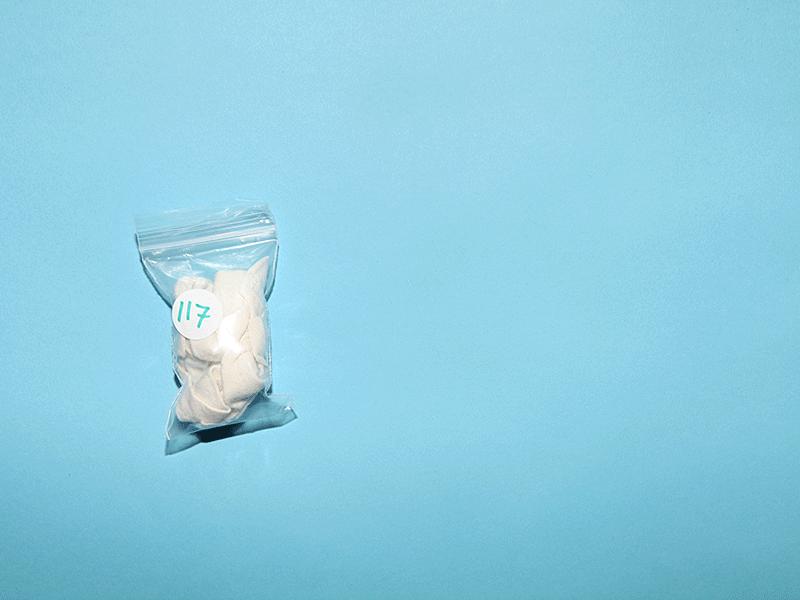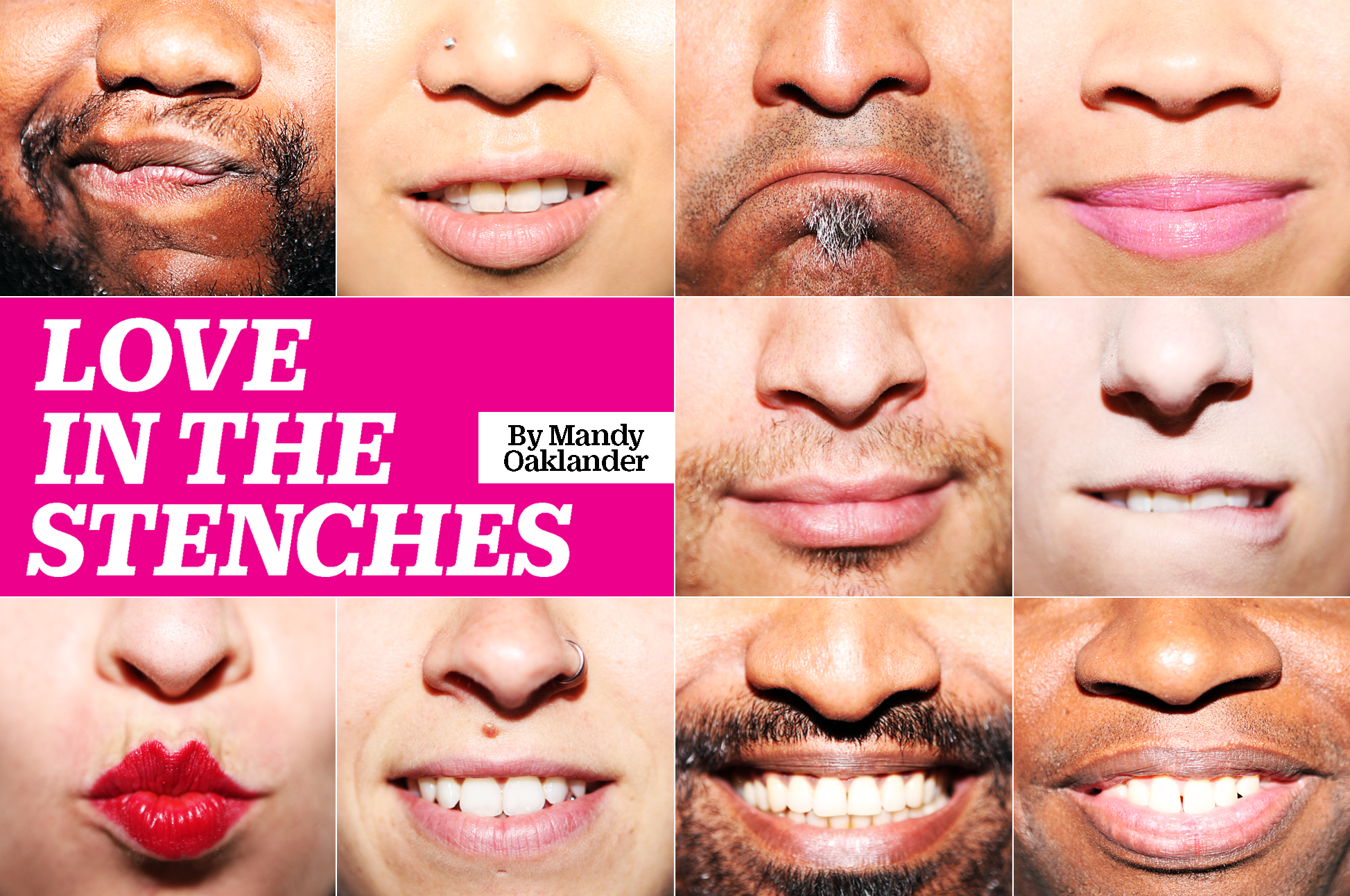Researchers believe that our unique bodily scent plays a larger role in our social lives than we know. Now, social media entrepreneurs are putting that science to the test. Can you sniff your way to love?
Everyone knows that to find true love, you have to be yourself. I’d never heard that you should also smell like yourself, though, until I joined a matchmaking service called Smell Dating. For three days and nights I wore the same cotton T-shirt, through sweaty workouts and while I slept. Showers were allowed. Deodorant was not. After 72 hours, the cotton was pickled in my essence.
I passed off the damp, stained tee to the New York University researchers who run Smell Dating, who saw it not as an object of disgust, but as boyfriend bait. They cut my T-shirt into swatches, stuffed them inside little zip-top bags and mailed them to 10 people who’d also signed up for this bizarre social experiment. I’d get stinky T-shirt samples, other people would get stinky T-shirt samples, and if by chance any two of us chooses each other’s odor, the NYU team will introduce us.
Smell Dating is the first mail-order smell dating service, but its creators aren’t the only ones wagering that we’re better at choosing partners through our noses than our eyes. By sniffing other people’s body odor instead of swiping right on their photos, the thinking goes, we rely on primal bodily intuition. A small but growing trend in social media is to go nose first when it comes to romance: whether by throwing get-togethers that hook people up based on the smell of their T-shirt, like Pheromone Parties, or by matching people based on how similarly they smell the world, like the Israeli social network SmellSpace. Whether interventions like these are successful is a current area of research.
It sounds like a gimmick, sure, but researchers believe that the nose plays a much larger role in our social lives than we realize. Not that we’ve given it much of a chance. Dating has quickly become a visual enterprise; in 2005, very few Americans had tried online dating, but now 15% have, and technology like Tinder, Instagram, Facebook and Snapchat reinforce the visual conventions that society says we should find attractive. Smell Dating, then, is a throwback—a way to connect us, at long last, with our most basic, biological mating cues.
The science of smell
In the game of “which sense would you most be willing to lose?” smell is always the first to be forfeited. But evolutionarily, smell is one of the most important senses. It helps us make sense of our environment by keeping us safe from spoiled food, for instance, and tipping us off to threats like fire or gas leaks. It’s also a highly social sense, linked to memory, emotions and interactions with other people—encouraging us to draw closer or stay away.
The nose also deserves credit for much of our pleasure, especially when it comes to another of our chemical senses: taste. “So much of we think of as taste is really smell,” says Richard Doty, director of the Smell and Taste Center at the University of Pennsylvania Medical Center. When we smell and chew something, like a chocolate chip cookie, odor molecules travel to the back of the nose, where they dissolve into mucus and bind to olfactory receptor cells. Those receptors rocket the smell directly to the brain, a much quicker route than other senses take. As a result, smell can trigger thoughts and behaviors very quickly. Catch a whiff of cookies baking, and you might suddenly be struck by a memory of mom. You might also start salivating.
Smelling a snack is simple compared to sniffing another member of the our species. Animals secrete pheromones, a distinct cocktail of chemicals that, in very small doses, have the power to influence how those animals respond to one another. These pheromones shape the social and sexual lives of some creatures, like invertebrates, insects and rodents, by attracting them towards evolutionarily compatible partners, which are desirable because they lead to better offspring. In these animals, genes in the major histocompatibility complex (MHC)—part of the immune system—produce unique odors; when another animal gets a whiff, they’re either attracted or repelled based on immune compatibility. Simply by using their sense of smell, mice end up choosing mates with MHC types that are not too similar, yet not too different, from their own, as a way to avoid inbreeding and to make their offspring evolutionarily as strong as possible.

Whether or not these odors play the same behavior-influencing role in human mate choice, however, is still up for some debate. Researchers agree that our sense of smell is important to human relationships, and that we are hard-wired to be drawn to people whose scent we like—be it from a bottle or their armpits. But the idea that humans emit invisible chemicals that could drive us to a partner is hardly the consensus today. Still, I wanted to give it a try. My first boyfriend had a smell I haven’t been able to shake years later, like dirt and earth and just-wet soil. “Ew,” my friends would tell me when I’d try to describe it. But breathing him in was powerful and delicious, and I liked the idea that his scent spoke just to me. The romantic part of me still can’t help thinking that smell communicates something deeper than what we can see, touch, hear or taste.
“The underlying theory is that you somehow select immune compatibility in a mate,” says Noam Sobel, an expert in olfaction and professor of neurobiology at the Weizmann Institute of Science in Israel. The human version of the MHC, called the human leukocyte antigen, or HLA, is also linked to a large number of olfactory receptors and appears to be particularly important for how we smell other people. Like the MHC, the HLA has genes that influence how one’s immune system recognizes cells as belonging to oneself or an invader; HLA fit is one test used to determine whether or not an organ donor and recipient will be compatible.
If humans were like rodents and insects, they’d sniff out body odor from mates with Goldilocks-like immune genes—not too similar, not too different. In some research, that’s exactly what happens. In a 2002 study published in Nature Genetics, researchers focused on the Hutterites, an isolated American religious community descended from a relatively small number of ancestors. The group therefore all had similar HLA genes. But studies of Hutterite spouses showed that partners didn’t tend to have very similar HLA genes. The researchers wanted to find out if women were sniffing out men with just-right HLA profiles. So they asked men in the community to give up deodorant and wear T-shirts for a few days—much like how NYU’s Smell Dating works—and took note of which shirts the women liked. Their odor preferences were indeed linked to the partner having just the right kind of HLA.
Sniffing out love
Other research in this area is mixed. “There are so many things going on with humans, in terms of how you select somebody you want to be with or get married to or have children with,” says Gary Beauchamp, emeritus director and president of the Monell Chemical Senses Center. “Isolating the odor part to it has been very, very difficult.” Animal studies are able to control for the diet, genes, upbringing and diseases that alter body odor, but that’s impossible to do in humans. Scientists can also expose lab animals to bodily secretions that would be far too unseemly to use in human studies. That means smell researchers are largely stuck with sweaty T-shirts, like the one I had just mailed off to a bunch of strangers (including my future boyfriend, I hope.)

Denise Chen, associate professor of neurology at Baylor College of Medicine, has spent a career exploring how human odors influence the behavior of those around them, and she’s done it by making her subjects sweat. She shows people horror films to collect fear sweat, comedies to collect happy sweat and erotica to gather sex sweat.
People can smell these emotional nuances, she found, suggesting that sweat is important to our social lives. When couples sniffed sweat samples from their partner and from strangers, they were better at naming the emotion behind the sweat—happy, fearful or horny—when it came from their partner. The longer they’d been together, the better they were at it. But they weren’t aware that they were doing it.
“I initially thought it would be so much easier to study humans than animals,” says Chen. Humans can talk, after all. “But smell acts at different levels of conscious awareness. I don’t find it easy at all.”
Another complicating factor is that humans very quickly imbue odors with meaning. “How we learn and label odors dictates largely whether we like them or not,” says Doty, who wrote a book called The Great Pheromone Myth. “An odor can either smell like puke or like the armpit of your lover.”
The 10 armpits I was about to sniff didn’t get the benefit of this romantic reframing. It smells like the first time we went camping isn’t a pass you can give a B.O.-soaked tee of unknown origin, so I expected them all to smell the same. Even though some would make me gag, I soon learned that others were actually appealing.
Social networks of smell
When it comes to romance, some researchers believe that a person’s sense of smell—not just how they smell, but how well they smell—may be just as important. And that appears to be far easier to measure.
A person’s nose has about 400 different types of olfactory receptors, and 6 million in total. That vast variation suggests that each person smells the world slightly differently, says the researcher Sobel. In a 2015 study published in the journal PNAS, Sobel and his colleagues found out that by testing how 238 people reacted to a series of odors, they could develop an algorithm to characterize a person’s unique sense of smell, which they dubbed an “olfactory fingerprint.” Blood tests revealed that a person’s olfactory fingerprint was significantly linked to their HLA type—so strongly that they could use it as a tool to screen bone marrow transplants, Sobel says.
Could a smell-based fingerprint also predict the quality of a relationship? That’s the subject of a forthcoming study, in which Sobel’s team took olfactory fingerprints from 222 couples—some of whom had been together a short time, others who had been married 35 years—and interviewed them. There was a “frighteningly strong” link between how similarly couples perceived the scents of the world and the success of their romantic relationship, Sobel says. Couples that smell together, stay together.

Sobel is determined to get as many people as possible to rate odors to improve his algorithm, so he decided to meet lovelorn masses in their natural habitat: the Internet. In April, he launched SmellSpace.com, the world’s first smell-based social network, where there are no selfies to post or favorite-first-date questions to answer. Instead, you scratch and sniff your way through a scent packet that Sobel sends you, trying to decipher the difference between wet dog and musk, to rate the spiciness levels of manure and garbage.
At the end, a user’s profile is nothing more than a smell score. Members are shown a list of similar smellers, who may be promising romantic candidates. In a way, it’s Sense of Smell Dating. “There’s no way to send your body odor to a million people right now,” Sobel says. “That’s why we’re pushing sense of smell.” Imagine the possibilities, he says, if SmellSpace could serve up a list of the most compatible mates out of millions. The website has a long way to go; right now, it has about 1,700 members, roughly 1,600 of whom live in Israel.
One of these users, an Israeli who read about SmellSpace in an article posted on Facebook, pings me with a message in Hebrew. I respond in English, asking him what he thinks of the service so far.
“I hope to find here some new friends and maybe a girlfriend to marry to,” he says.
“Do you think it’s possible to find a girlfriend based on similar senses of smell?” I ask him.
“I don’t know,” he replies. “I want to try.”
The sniff test
The T-shirts of my prospective lovers are stuffed into small numbered baggies. I unseal each of them, one at a time, and inhale deeply. The first is ripe with sweet, nauseating body odor so thick I nearly choke. The second smells like stale tobacco. Some swatches are spicy, while others are inoffensive, and even kind of nice. “Like sweet laundry detergent,” I jot down for one. “He’s like, ‘Look how cute I am!'” I write for another.
I mark my six favorites on the Smell Dating website, and instantly, I have my matches. Only two sweaty T-shirt wearers also choose me. This kind of rejection feels worse than an unrequited photo swipe. The vast majority of smell daters sniffed me, and passed.
But maybe my apparently narrow smell appeal meant that my matches were all the more special, I tell myself. I open my Smell Dating email and find that we’ve been connected by our personal email addresses—not by faceless phone numbers, which the website had promised. I immediately Google my matches, assuming they’ll do the same to me, and the service turns into Tinder: a dating pool ruled by what the eye sees, not what the nose knows. Neither of my matches agree to meet me in person. The smell spell is broken.
